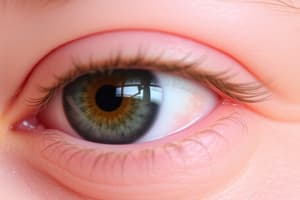Podcast
Questions and Answers
What is the main reason for developing ptosis according to the text?
What is the main reason for developing ptosis according to the text?
- Congenital irregularities in the levator muscles
- Inflammatory conditions impacting the levator palpebrae superioris
- Neurological problems affecting the levator palpebrae superioris muscle
- Age-related changes in the muscles and connective tissues supporting the eyelid (correct)
Which condition can cause ptosis due to an autoimmune attack on critical nerve signaling proteins?
Which condition can cause ptosis due to an autoimmune attack on critical nerve signaling proteins?
- Congenital ptosis
- Myasthenia gravis (correct)
- Horner syndrome
- Head trauma-induced oculomotor nerve injury
What can result in unilateral (one-eyed) ptosis due to the nerves controlling blood vessels and sweat glands around the eyes and face?
What can result in unilateral (one-eyed) ptosis due to the nerves controlling blood vessels and sweat glands around the eyes and face?
- Horner syndrome (correct)
- Congenital factors
- Age-related changes in tendons
- Neurological problems like myasthenia gravis
How can head trauma potentially lead to ptosis?
How can head trauma potentially lead to ptosis?
What is a possible cause of congenital ptosis?
What is a possible cause of congenital ptosis?
Which of the following is NOT mentioned as a potential cause of ptosis in the text?
Which of the following is NOT mentioned as a potential cause of ptosis in the text?
What can potentially induce ptosis as a complication after healing occurs from surgical procedures near the eye area?
What can potentially induce ptosis as a complication after healing occurs from surgical procedures near the eye area?
Which medication class can potentially produce ptosis as a side effect?
Which medication class can potentially produce ptosis as a side effect?
In extremely unusual circumstances, what may manifest as ptosis due to genetic mutations?
In extremely unusual circumstances, what may manifest as ptosis due to genetic mutations?
What treatment options for ptosis can vary depending on the causal factor?
What treatment options for ptosis can vary depending on the causal factor?
Which tumors affecting specific areas might indirectly influence the progression of ptosis?
Which tumors affecting specific areas might indirectly influence the progression of ptosis?
What non-surgical intervention can be used as a treatment for ptosis?
What non-surgical intervention can be used as a treatment for ptosis?
Study Notes
Understanding Ptosis: Causes Behind Drooping Eyelids
Ptosis is a medical condition characterized by the drooping of one or both eyelids due to weakness or relaxation of the eye's upper muscle, called the levator palpebrae superioris. This impairment can impact vision, cause cosmetic concerns, and lead to secondary issues if left untreated. To better grasp this condition, let's delve into its potential underlying causes.
Age-Related Changes
The most common reason for developing ptosis is age-related changes within the muscles and connective tissues supporting the eyelid. As we grow older, the tendons connecting these muscles gradually stretch out, causing the lids to sag over time.
Neurological Problems
Neuromuscular disorders such as myasthenia gravis—an autoimmune disease where antibodies target critical proteins needed for proper nerve signaling—can also result in ptosis. Other neurologic conditions like Horner syndrome, which affects the nerves controlling blood vessels and sweat glands around the eyes and face, may present with unilateral (one-eyed) ptosis. In some cases, head trauma resulting in injury to the oculomotor nerve can trigger ptosis.
Congenital Factors
Some individuals are born with weakened levator muscles, leading to ptosis from birth. However, the severity of congenital ptosis varies widely among affected individuals, primarily ranging from mild to moderate conditions.
Postoperative Complications
Surgical procedures performed near the eye area, particularly those involving cataracts removal or lid surgery, have been known to induce ptosis as a rare complication after healing has occurred.
Toxicity & Medications
A variety of medications used across different therapeutic classes, including beta blockers, anticholinergic agents, and botulinum toxin (Botox), can potentially produce ptosis as a side effect. Long-term utilization of certain drugs, exposure to heavy metals, and toxic chemicals can all contribute to the development of the condition.
Rare Conditions
In extremely unusual circumstances, genetic mutations causing myopathies (muscle diseases) may manifest as ptosis. Additionally, specific tumors affecting the orbit, brainstem, or cranial nerves might indirectly influence the progression of ptosis.
Though it typically presents slowly, once diagnosed correctly, treatment options for ptosis vary depending upon the causal factor. Common treatments range from non-surgical interventions – such as using eyeglasses, contact lenses, or temporary splinting – to surgical techniques designed to tighten underlying muscles, remove extra skin, or reposition fatty tissue beneath the eyebrow area.
Studying That Suits You
Use AI to generate personalized quizzes and flashcards to suit your learning preferences.
Description
Explore the various factors contributing to ptosis, a condition characterized by drooping eyelids due to muscle weakness. Learn about age-related changes, neurological problems, congenital factors, postoperative complications, toxicity from medications, and rare conditions. Discover the treatment options available based on the underlying cause.




